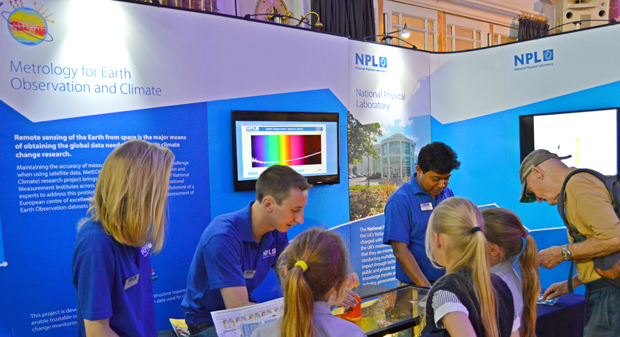NPL gives the public a new perspective on Earth and climate change


The National Physical Laboratory (NPL) attended Cheltenham Science Festival and demonstrated how satellites can be used to observe the Earth’s surface. As one of the UK’s most prestigious and popular science festivals, the event was an ideal setting to explain the work of NPL, and to give the public the opportunity to see the Earth from a new perspective.
An annual celebration of science
Each summer, Cheltenham Science Festival holds six days of talks, practical demonstrations, debates and experiments. Speakers this year included Richard Dawkins, Alice Roberts and Jim al Khalili; and visiting institutions included the BBC and GCHQ, alongside NPL.
Volunteers from NPL manned a stand at the Festival to demonstrate satellite Earth observation and spectroscopy to members of the public.
A new perspective on our planet
Orbiting satellites enjoy a view of the Earth that few will ever experience (except astronauts). But satellite observation gives scientists access to an off-world perspective, and at Cheltenham NPL gave members of the public a taste of this different perspective.
Visitors to our stand used a spectrometer inside a model satellite to analyse the light reflected off samples of the Earth’s surface, including a rainforest (a shrub), deforested land (bare soil), a desert (sand), and a degraded grassland (plastic grass). The demonstration showed the different wavelengths of light reflected by each sample (the spectral signature) and how these can be used to identify different types of land cover.
Members of the public were interested to find out how satellites can be used in this way to monitor processes on a range of scales, from assessing the health of agricultural crops, to monitoring global climate change. A number of visitors to the stand were also pleasantly surprised to realise our sample of plastic grass was in fact fake when they analysed it with the satellite and revealed its unusual spectral signature (low near-infrared reflectance).
Monitoring climate change
This year’s stand was inspired by MetEOC, a project led by NPL to develop new calibration methods for Earth observation satellites, to enhance the accuracy of their measurements. The project is part of a broader movement in the measurement science community to provide ever more accurate Earth observation data to climate scientists. Ultimately, this work will allow the development of more sophisticated climate models, which are used to inform policy and develop strategies to mitigate climate change.
Impact through engagement
The Festival was an ideal opportunity to explain the work of NPL to non-scientists, and to discuss climate change and climate research. Visitors to our stand ranged from future scientists at primary school (and some even younger) to those ‘well past retirement age’. It was a delight to meet so many people with a passion for science and a curiosity about climate research.
Ally Barker, from NPL’s Earth Observation, Climate and Optical Group, commented:
“This was a brilliant opportunity to share some of NPL’s science with the wider public. It was great to meet so many people who are so interested and passionate about science, and increase awareness of our urgent need to act on climate change”.
NPL will be back again next year.